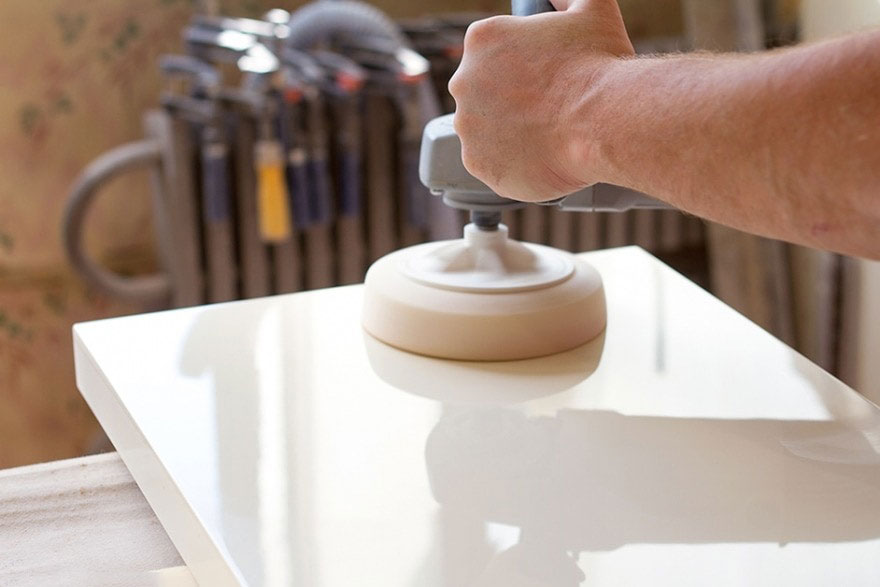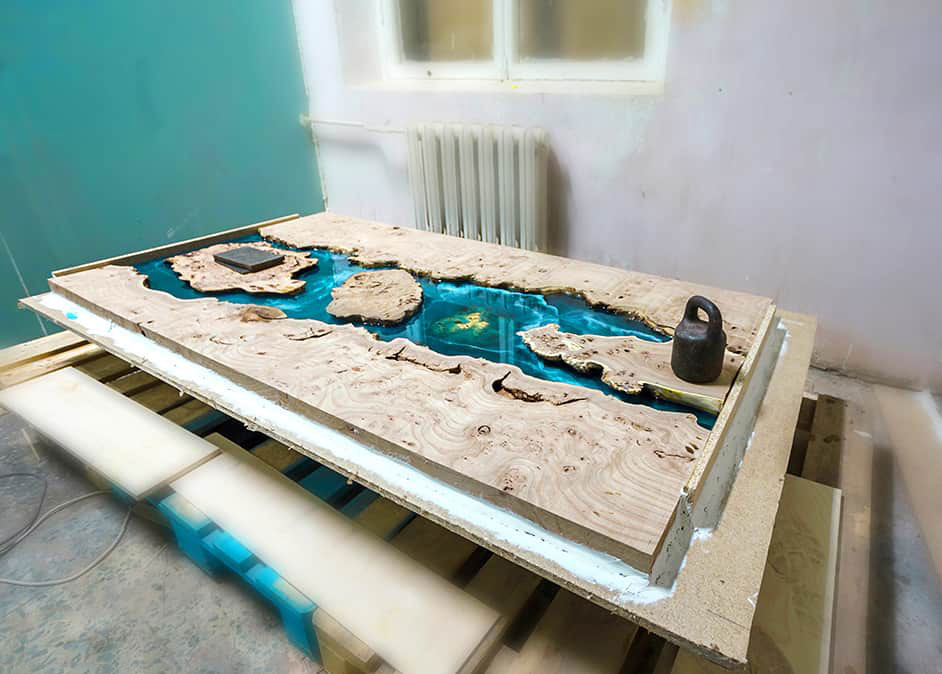- It is one of the epoxy mold release agents you can use on porous surfaces. So, this would be your choice for using on wood, but you should apply at least several layers to be effective.
- You can use it for both intricate as well as larger areas.
- Can be used for polyester resin, PMMA, polyurethane and casting resin.
- Free of silicone and any gases harmful to the environment.
- Effortless to use, even for beginners.
- Offers the best release effect and demolds flawlessly
Mold Release Wax
The mold release wax comes in a container as wax and does not come in spray form. Most come in a liquid form, but others have a paste-like consistency. The wax can easily be applied with a brush or cloth. Put it directly from the container onto your cloth, which you can then use to rub onto your mold. You can also use the wax on other surfaces besides silicone.
After you have applied the wax to your mold and after your resin project has cured, when removed, the surface may appear dull. You can easily remedy this by polishing it until it becomes shiny.

Best use for Mold Release Wax
The best way you can use release wax is on flat large surfaces. If you have a more detailed mold, it is better to use the mold release spray instead. Even if you use a cloth with the wax, it may be difficult to get into those small and difficult corners.
You can usually use a mold many times over, but it is advisable to clean the mold thoroughly after each use. You can easily clean your mold with some warm water and a bit of steel wool, this should remove any wax residue.
Applying the Mold Release Wax
When using a wax release, it is mostly in a liquid form, so shaking it before use is recommended. By doing this, the solvent and wax which can separate over time will mix again. Next, you can simply remove the wax with a spatula, then place onto a clean soft cloth. Apply the wax to the mold with the cloth.
Leave the wax for about 5-minutes, you can then take another clean cloth to polish the wax. When it comes to new molds, you may have to apply another layer. You should leave the first layer overnight before applying the second layer. To give the wax a more polished look, you can treat it with some PVA release lacquer.
We Recommend: Orca Shimmer mold Release Wax
You can use the Orca Shimmer Mold Release Wax on all forms of resin, and it offers many benefits. Because of this, we highly recommend this product.
Let us have a look at a few pros and cons when it comes to using the Orca Shimmer Mold Release Wax:
Pros
- The silicone mold release wax for resin can be used with a PVA release lacquer for a more polished effect. You do not have to add the PVA if you have properly polished the wax.
- The wax release agent is highly effective due to its consistency.
- The wax works not only well on epoxy resin, but also in polyester resin, topcoat, and Gelcoat resin.
- It is extremely easy to apply the wax and also to remove it.
Cons
- You cannot use the wax release agent on wood and other porous materials unless you first apply the proper release sealant or lacquer.
- The price of Orca Shimmer Mold Release Wax might be costly compared to other similar products, but the benefits are more than enough to offset this disadvantage.
When it comes to applying the wax release agent, it is important to note the flash-off time. When applying more than one layer of wax, you should wait overnight before applying the next layer. You should follow this rule as it prevents the wax form blending with the resin. When pouring your resin, the wax in your mold should not be sticky but smooth and tack-free.
PVA Release Lacquer
The Lacquer is used as a mold release agent, but also to help demold castings. Spray a layer onto your negative mold and is used in the same way as a release spray, creating a layer or film. The lacquer is made of polyvinyl alcohol and acts as an excellent mold release coating.

Best use for PVA Release Lacquer
To obtain best results, in most cases the PVA release lacquer is used together with a wax release agent when used for epoxy resin. The lacquer acts as a second barrier between the resin and the mold.
This ensures that you have an easy and perfect demolding process and also provides a high-gloss surface. When using PVA release lacquer you do not need to polish your cured resin item. Furthermore, you can use it on porous as well as sealed surfaces like wood, plaster, melamine, or resin press plates.
Applying PVA Release Lacquer
Applying the PVA epoxy release agent can be done in a variety of ways. You can use a brush, sponge, or you can use a spray gun. The best way to apply is to use a crossways motion. First, apply along the surface or up and down, then apply across or from left to right, and then again along end-to-end.
You should apply at least three layers, a thin first coat, which you should allow to dry or flash-off for about 10-15 minutes. Then apply a thicker second and third layer, between each layer, you should wait 10-15 minutes for the lacquer to dry thoroughly before moving on. Once you demold your casting, you should be able to effortlessly remove any residue using a sponge and a bit of warm water.
We Recommend: Partall PVA Release Agent
This is a great product for silicone, wood, and many other materials. Let us have a look at a few pros and cons when it comes to using Partall PVA Release Agent.
Partall PVA Release Agent Pros
- Best product for producing high-gloss surfaces.
- You can easily blend it with a wax release agent for added benefits.
- An extremely concentrated product that is affordable.
- You can even use it with polyester resins, which demolds effortlessly.
- You can use it for epoxy and casting resin as well as for topcoat and gelcoat resin.
There does not seem to be any real cons to the Partall PVA Release product, as it does what it says. The product is easy to use, with excellent demolding results. The product is the best mold release agent for all types of resin but is particularly good when used together with epoxy resin.

Substitutes you can use in place of commercial mold release agents
Petroleum Jelly
Petroleum jelly is best used on plain molds that do not have delicate details. You can easily apply a thin layer to your mold by hand. If you do apply on more detailed molds, the jelly might cover up the finer details, which will then affect the final result.
Mineral or Vegetable Oil
Both these oils make a good mold release agent and can easily be applied with paper toweling. Be careful not to add too much oil, as it could pool. This can be remedied by using the paper towel, which will absorb any access oil.
Spray and Cook
Commonly used when cooking to keep food from sticking to a pan or other cookware. Easily available, spray and cook is a non-stick spray which is excellent to use as a mold release agent. The non-toxic spray will not damage your mold or the resin. Simply remove any residue from your final resin item with a clean cloth.
Talcum Powder
Talcum powder works great as a silicone mold release agent, but on molds that have fewer details. For example, a half-sphere mold or gem-shaped mold. Talcum powder does not work with solid or hard molds or molds with more details. This is because the powder does not cover the mold properly, so it won’t prevent the resin from sticking to these areas.
A Guide for effortless Demolding
To effortlessly release your casting from the mold, you will need to take note of the following. It is all subject to the size of your mold and its design. When demolding, first try to work the edges loose. This should start the demolding process in most cases, some castings even come out straight away when turned upside down.
When you first attempt does not work, you can then try some demolding wedges. You can easily purchase these at your local hardware store or online. The wedges are also perfect for undoing two-part molds. You can also tap the mold softly with a rubber mallet to help dislodge your item from the mold. Another method to help with demolding if you have the equipment is to use compressed air.
When using epoxy resin, it depends on what mold you will be using to decide what mold release agent is best.
- Two-dimensional molds: a release wax works best.
- Detailed molds: mold release spray works best.

Questions and Answers
Can you explain what Mold Release Wax is?
Mold release wax is a substance used to avoid the binding of resin or other molding materials to a mold. Best to use on larger, flat casting molds, which forms a layer between your mold and your casting agent. This prevents your casting from sticking to the mold.
Can you explain what Release Spray is?
Mold release spray is a substance that stops items from sticking to surfaces or to each other. The spray forms a layer or barrier between the mold and casting agent, making demolding an effortless process.
Are there alternative Mold Release Agents?
You can use common materials like vegetable oil, mineral oil, cooking spray or petroleum jelly. This is a much cheaper way than commercial mold release agents.
Can the WD-40 Lubricant Act as a Mold Release Agent?
This product is made out of potent acids, which can seep into rust. Although the lubricant will only dry out your skin if exposed, it will certainly damage your mold. Also, it has an extremely thin consistency and won’t stick to the mold surface.






